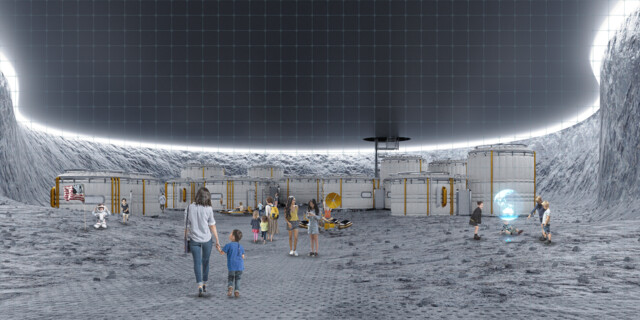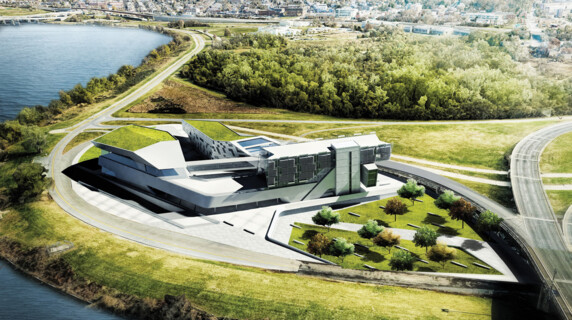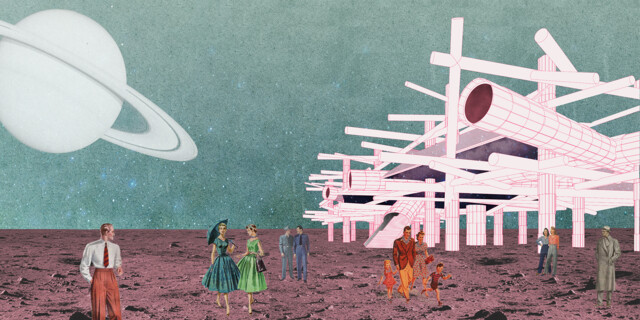- wa-ID
- wa-2027215
- Tag der Veröffentlichung
- 02.08.2019
- Aktualisiert am
- 05.03.2020
- Verfahrensart
- Offener Wettbewerb
- Zulassungsbereich
-
Andere
- Teilnehmer
- Keine Teilnahmebeschränkung
- Auslober
- UNI - UNIEGIS NETWORK Private Limited
- Bewerbungsschluss
- 15.12.2019
- Abgabetermin
- 25.12.2019
- Preisgerichtssitzung
- 25.01.2020
- Bekanntgabe
- 24.02.2020
Verfahrensart
Offener Ideenwettbewerb
Wettbewerbsaufgabe
Vor 50 Jahren, am 20. Juli 1969, betrat Neil Armstrong als erster Mensch den Mond. Bei der Landung waren die ersten Worte, die er zitierte: Das ist ein kleiner Schritt für den Menschen, ein Riesenschritt für die Menschheit. Getreu seinen Worten hat die Welt seither nie wieder zurückgeblickt, und nach diesem Tag wurden neue Dimensionen der Weltraumforschung eröffnet. Jede Weltraummission hat die Menschheit immer dazu inspiriert, über den Tellerrand hinaus zu schauen, und diese erstaunliche Leistung war der Höhepunkt dieser Bemühungen.
In den letzten Jahrzehnten hat die Raumfahrt und die Erforschung des Weltraums ein bedeutendes öffentliches Interesse verloren, doch unsere jüngsten Innovationen haben die Neugierde auf diesem Gebiet erneut geweckt.
Die Apollo-11-Mission war nicht nur ein Sprung in der wissenschaftlichen Leistung, sondern eine Quelle der Inspiration und Motivation für die kommenden Generationen. Astronaut zu werden, wurde für Kinder in den USA und weltweit zu einer der gefragtesten Berufswünsche.
Der Traum von der Mondreise ist im Laufe der Zeit nur noch eskaliert: 2016 haben sich mehr als 18.300 Menschen für weniger als 14 Plätze in der NASA-Astronautenklasse beworben, was fast das Dreifache der Bewerbungen im Jahr 2012 ausmacht. Bei einem solchen Tempo könnte es eine Zeit geben, in der jeder Haushalt einen Astronauten haben würde.
Doch hinter einer Weltraummission steckt viel, um sie unabhängig von den Astronauten durchzuführen. Mehrere Ingenieure, Techniker, ausgebildete Fachkräfte, Spezialisten, Wissenschaftler und Designer ermöglichen diese Missionen, während sie hinter den Kulissen arbeiten.
Die Herausforderung besteht darin, ein Raumfahrtzentrum zu entwerfen, um die junge Generation über die Mondreise, die Rolle der verschiedenen Menschen und andere Fortschritte bei der Erforschung des Weltraums aufzuklären.
Competition assignment
50 years ago, on July 20, 1969, Neil Armstrong became the first man to step on the moon. Upon landing, the first words that he quoted were “That‘s one small step for man, one giant leap for mankind.” True to his words, the world has never seen back since and new dimensions of space explorations were open following that day. Every space mission has always inspired humanity to think beyond and, this marvellous feat has been the pinnacle of those.
In the past few decades space travel and exploration has lost a significant public interest, however, our recent innovations have again sparked the curiosity in this domain.
The Apollo 11 mission wasn’t just a leap in scientific achievement, it was a source of inspiration and motivation for generations to come. Becoming an astronaut became one of the most sought-after career choices for kids in the USA and worldwide.
The moontrip dream has only escalated over time with more than 18,300 people applying for fewer than 14 spots in NASA‘s astronaut class in 2016, which is nearly triple of applications in 2012. At such pace, there might be a time when every household would have an astronaut.
However, a lot goes behind a space mission to make it happen apart from the astronauts. Several engineers, technicians, trained professionals, specialists, scientists and designers make these missions possible while being behind the lines.
The Challenge is to design a space center to enlighten young generation about the moontrip, the role of different people and other advancements in space explorations.
Preisgericht / Jury
Brand Norman Griffin, Program Manager, Genesis Engineering Solutions, United States
Emanuel Dimas de Melo Pimenta, CEO | Architect, Space Architect, Urban Planner at Emanuel Dimas de Melo Pimenta Associated Architects
Mark Kerr, Architect, U.S. Army Corps of Engineers (USACE), USA
Barbara Imhof, CEO, Co-founder, Liquifer Systems Group, Austria
KIM Kyunghwan, Founder, BiB Lab, France
Kevin Scholtes, Stage Responsible Engineer, Firefly Aerospace
Weitere Informationen zu den Gewinnern finden Sie unter /
More information about the winners can be found at:
uni.xyz/competitions/moontrip/info/about
Offener Ideenwettbewerb
Wettbewerbsaufgabe
Vor 50 Jahren, am 20. Juli 1969, betrat Neil Armstrong als erster Mensch den Mond. Bei der Landung waren die ersten Worte, die er zitierte: Das ist ein kleiner Schritt für den Menschen, ein Riesenschritt für die Menschheit. Getreu seinen Worten hat die Welt seither nie wieder zurückgeblickt, und nach diesem Tag wurden neue Dimensionen der Weltraumforschung eröffnet. Jede Weltraummission hat die Menschheit immer dazu inspiriert, über den Tellerrand hinaus zu schauen, und diese erstaunliche Leistung war der Höhepunkt dieser Bemühungen.
In den letzten Jahrzehnten hat die Raumfahrt und die Erforschung des Weltraums ein bedeutendes öffentliches Interesse verloren, doch unsere jüngsten Innovationen haben die Neugierde auf diesem Gebiet erneut geweckt.
Die Apollo-11-Mission war nicht nur ein Sprung in der wissenschaftlichen Leistung, sondern eine Quelle der Inspiration und Motivation für die kommenden Generationen. Astronaut zu werden, wurde für Kinder in den USA und weltweit zu einer der gefragtesten Berufswünsche.
Der Traum von der Mondreise ist im Laufe der Zeit nur noch eskaliert: 2016 haben sich mehr als 18.300 Menschen für weniger als 14 Plätze in der NASA-Astronautenklasse beworben, was fast das Dreifache der Bewerbungen im Jahr 2012 ausmacht. Bei einem solchen Tempo könnte es eine Zeit geben, in der jeder Haushalt einen Astronauten haben würde.
Doch hinter einer Weltraummission steckt viel, um sie unabhängig von den Astronauten durchzuführen. Mehrere Ingenieure, Techniker, ausgebildete Fachkräfte, Spezialisten, Wissenschaftler und Designer ermöglichen diese Missionen, während sie hinter den Kulissen arbeiten.
Die Herausforderung besteht darin, ein Raumfahrtzentrum zu entwerfen, um die junge Generation über die Mondreise, die Rolle der verschiedenen Menschen und andere Fortschritte bei der Erforschung des Weltraums aufzuklären.
Competition assignment
50 years ago, on July 20, 1969, Neil Armstrong became the first man to step on the moon. Upon landing, the first words that he quoted were “That‘s one small step for man, one giant leap for mankind.” True to his words, the world has never seen back since and new dimensions of space explorations were open following that day. Every space mission has always inspired humanity to think beyond and, this marvellous feat has been the pinnacle of those.
In the past few decades space travel and exploration has lost a significant public interest, however, our recent innovations have again sparked the curiosity in this domain.
The Apollo 11 mission wasn’t just a leap in scientific achievement, it was a source of inspiration and motivation for generations to come. Becoming an astronaut became one of the most sought-after career choices for kids in the USA and worldwide.
The moontrip dream has only escalated over time with more than 18,300 people applying for fewer than 14 spots in NASA‘s astronaut class in 2016, which is nearly triple of applications in 2012. At such pace, there might be a time when every household would have an astronaut.
However, a lot goes behind a space mission to make it happen apart from the astronauts. Several engineers, technicians, trained professionals, specialists, scientists and designers make these missions possible while being behind the lines.
The Challenge is to design a space center to enlighten young generation about the moontrip, the role of different people and other advancements in space explorations.
Preisgericht / Jury
Brand Norman Griffin, Program Manager, Genesis Engineering Solutions, United States
Emanuel Dimas de Melo Pimenta, CEO | Architect, Space Architect, Urban Planner at Emanuel Dimas de Melo Pimenta Associated Architects
Mark Kerr, Architect, U.S. Army Corps of Engineers (USACE), USA
Barbara Imhof, CEO, Co-founder, Liquifer Systems Group, Austria
KIM Kyunghwan, Founder, BiB Lab, France
Kevin Scholtes, Stage Responsible Engineer, Firefly Aerospace
Weitere Informationen zu den Gewinnern finden Sie unter /
More information about the winners can be found at:
uni.xyz/competitions/moontrip/info/about
Moontrip – Inspiring humanity to explore beyond earth
Organizers
UNI, UNIEGIS NETWORK Private Limited, New Delhi
Overview
50 years ago, on July 20, 1969, Neil Armstrong became the first man to step on the moon. Upon landing, the first words that he quoted were “That‘s one small step for man, one giant leap for mankind.” True to his words, the world has never seen back since and new dimensions of space explorations were open following that day. Every space mission has always inspired humanity to think beyond and, this marvellous feat has been the pinnacle of those.
In the past few decades space travel and exploration has lost a significant public interest, however, our recent innovations have again sparked the curiosity in this domain.
The Apollo 11 mission wasn’t just a leap in scientific achievement, it was a source of inspiration and motivation for generations to come. Becoming an astronaut became one of the most sought-after career choices for kids in the USA and worldwide.
Challenge
The moontrip dream has only escalated over time with more than 18,300 people applying for fewer than 14 spots in NASA‘s astronaut class in 2016, which is nearly triple of applications in 2012. At such pace, there might be a time when every household would have an astronaut.
However, a lot goes behind a space mission to make it happen apart from the astronauts. Several engineers, technicians, trained professionals, specialists, scientists and designers make these missions possible while being behind the lines.
The Challenge is to design a space center to enlighten young generation about the moontrip, the role of different people and other advancements in space explorations.
Competition Type
Open competition
Admission Area
International
Eligibility
- Minimum eligible age for participation is 18 years.
- There is no restriction to the degree or design disciplines to participate in the challenge.
- Participation in the competition can happen in a team as well as an individual.
- Maximum numbers of participants in a team are 4.
- The challenge is open worldwide for anyone to participate.
Schedule
Registration ends: December 15, 2019
Submission ends: December 25, 2019
Shortlist entries announced: January 04, 2020
Jury evaluation: January 04 – 25, 2020
Public voting ends: January 25, 2020
Results announcement: February 04, 2020
More information and documents at











